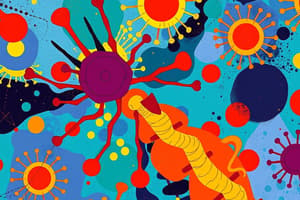Podcast
Questions and Answers
Which cellular process is activated by engaging apoptotic receptors?
Which cellular process is activated by engaging apoptotic receptors?
- Cell differentiation
- Cell division
- Autophagy
- Apoptosis (correct)
What is the primary focus of virology according to the text?
What is the primary focus of virology according to the text?
- Cell biology (correct)
- Genetics
- Biochemistry
- Immunology
How do non-enveloped and enveloped viruses enter cells?
How do non-enveloped and enveloped viruses enter cells?
- Pinocytosis
- Endocytosis (correct)
- Exocytosis
- Phagocytosis
What is critical for uncoating or disassembling viruses within cells?
What is critical for uncoating or disassembling viruses within cells?
Where does viral replication and assembly primarily occur?
Where does viral replication and assembly primarily occur?
How do viruses achieve exit from the endosome into the cytosol?
How do viruses achieve exit from the endosome into the cytosol?
What mechanism do viruses use to mimic apoptotic fragments for efficient uptake?
What mechanism do viruses use to mimic apoptotic fragments for efficient uptake?
Which transcriptional targets inhibit host cell receptors receiving pro-inflammatory signals from neighbouring cells?
Which transcriptional targets inhibit host cell receptors receiving pro-inflammatory signals from neighbouring cells?
What are some transcriptional targets that are secreted factors for neighbouring cells?
What are some transcriptional targets that are secreted factors for neighbouring cells?
Which class of viral fusion proteins can be activated upon docking to cell surface receptors or require pH transitions to become activated?
Which class of viral fusion proteins can be activated upon docking to cell surface receptors or require pH transitions to become activated?
Where does viral genome replication typically occur for RNA viruses?
Where does viral genome replication typically occur for RNA viruses?
How does the egress from the nucleus of enveloped viruses occur?
How does the egress from the nucleus of enveloped viruses occur?
Where does Herpesvirus bud into?
Where does Herpesvirus bud into?
What is the target of the vaccine for SARS-CoV-2?
What is the target of the vaccine for SARS-CoV-2?
Which entry pathways for SARS-CoV-2 require ACE2 receptor binding?
Which entry pathways for SARS-CoV-2 require ACE2 receptor binding?
What is required for S2 essential for viral fusion in SARS-CoV-2?
What is required for S2 essential for viral fusion in SARS-CoV-2?
How does influenza virus infection involve viral glycoproteins?
How does influenza virus infection involve viral glycoproteins?
What is a characteristic of rotavirus, a non-enveloped virus?
What is a characteristic of rotavirus, a non-enveloped virus?
How does rotavirus enter cells?
How does rotavirus enter cells?
What explains viral protein interaction with the endosomal membrane during viral escape?
What explains viral protein interaction with the endosomal membrane during viral escape?
What was identified as major determinants of rotavirus infection, linking the viral life cycle with host cell biological processes?
What was identified as major determinants of rotavirus infection, linking the viral life cycle with host cell biological processes?
How does picornavirus RNA exit the capsid?
How does picornavirus RNA exit the capsid?
What do over 75,000 viral genomes code for?
What do over 75,000 viral genomes code for?
Which type of life cycle do NOT ALL bacteriophages go into?
Which type of life cycle do NOT ALL bacteriophages go into?
What results from the integration of a phage genome into the bacterial genome?
What results from the integration of a phage genome into the bacterial genome?
What do bacteriophages inject through the bacterial wall?
What do bacteriophages inject through the bacterial wall?
What resulted in the identification of the Crispr-Cas9 gene editing system?
What resulted in the identification of the Crispr-Cas9 gene editing system?
What makes phage therapy very promising as an antibacterial treatment?
What makes phage therapy very promising as an antibacterial treatment?
What can phages re-evolve to overcome bacterial anti-viral strategies?
What can phages re-evolve to overcome bacterial anti-viral strategies?
Flashcards are hidden until you start studying
Study Notes
Viral Life Cycle and Host Interaction
- Phages are abundant and do not disturb the microbiome, making them a potential alternative to antibiotics
- Phages can self-replicate and lyse cells, making phage therapy an efficient system to improve antibiotic potency
- Over 75,000 viral genomes have been sequenced, coding for 2 to 2000 proteins
- Influenza virus infection involves viral glycoproteins attaching to host epithelial cells, followed by viral RNA and protein assembly into new virions
- Animal viruses can be enveloped or non-enveloped, with different characteristics and entry mechanisms
- Rotavirus, a non-enveloped virus, causes acute gastroenteritis and led to the death of ~453,000 children under 5 in 2008
- Rotavirus enters cells through clathrin and non-clathrin mediated endocytosis, requiring specific cellular factors for viral exit from the endosome
- Viral exit from the endosome generally relies on pH transitions, which can open helical proteins in capsid proteins or activate viral proteases
- The "carpet model" and "pore formation" model explain viral protein interaction with the endosomal membrane during viral escape
- Picornavirus RNA exits the capsid through a pore, driven by a pH change and dissociation of viral proteins
- A genome-wide siRNA screen identified host genes that either increased or decreased rotavirus infection, linking the viral life cycle with host cell biological processes
- AMPK and vacuolar ATP synthase were identified as major determinants of rotavirus infection, with links to endosomal acidification and mTOR signaling.
Studying That Suits You
Use AI to generate personalized quizzes and flashcards to suit your learning preferences.




